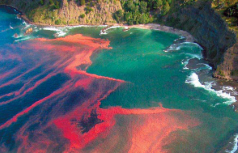What is Phytoplankton Blooms?
Recent studies reveal a concerning link between desertification and oceanic phytoplankton blooms. Researchers have observed important changes in the Indian Ocean, particularly southeast of Madagascar, which experienced the largest phytoplankton bloom in nearly three decades, attributed to nutrient-rich dust from drought-stricken regions in southern Africa.
Phytoplankton Importance
Phytoplankton are microscopic algae crucial for Earth’s ecosystems, which generate about 50% of the oxygen we breathe. They also play a vital role in the global carbon cycle. These organisms form the base of marine food webs, supporting various marine life.
Phytoplankton blooms occur under specific conditions. They require adequate light, nutrients, and suitable temperatures. When these factors align, phytoplankton multiply rapidly, resulting in important changes in water color due to chlorophyll presence.
Recent Bloom Details
The bloom southeast of Madagascar covered approximately 2,000 square kilometres. It emerged in late 2019, a period typically not associated with such blooms. Researchers tracked water movements to determine nutrient sources. Surprisingly, 75% of the nutrients originated from dust carried by winds from distant drylands.
Dust Sources
Dust emissions from regions like Namibia and Botswana contribute to ocean fertilisation. These areas experience drought, leading to important dust production. Wind transports this dust into the ocean, particularly during heavy rainfall events.
With ongoing climate change, similar blooms may become more frequent. Rising temperatures and increased dryness in southern Africa could enhance dust emissions. This pattern raises concerns about the potential impact on marine ecosystems and carbon absorption.
Research Significance
The findings highlight a complex relationship between global warming, drought, and oceanic nutrient dynamics. While this bloom was rare, it signals possible future trends. Further research is essential to understand the long-term effects on marine life and atmospheric carbon levels.
With ongoing climate change, similar blooms may become more frequent. Rising temperatures and increased dryness in southern Africa could enhance dust emissions. This pattern raises concerns about the potential impact on marine ecosystems and carbon absorption.
Research Significance
The findings highlight a complex relationship between global warming, drought, and oceanic nutrient dynamics. While this bloom was rare, it signals possible future trends. Further research is essential to understand the long-term effects on marine life and atmospheric carbon levels.
#BoneCancer #Osteosarcoma #CancerAwareness #BoneHealth #CancerSupport #EwingsSarcoma #Chondrosarcoma #CancerTreatment #FightCancer #HopeForACure
World Cell Biologist Awards:
Website Link : cellbiologist.org
Nomination Link : cellbiologist.org/award-nomination/?ecategory=Awards&rcategory=Awardee Contact Us: contact@cellbiologist.org
Follow Us On :
Twitter : twitter.com/account/access
Blogger : blogger.com/u/1/blog/posts/1155994660171864058
Pinterest :pinterest.com/researchs625/?actingBusinessId=907757006050531250
Linkedin : .linkedin.com/in/research-scholar-10278a323/
Tumblr ; tumblr.com/




Comments
Post a Comment